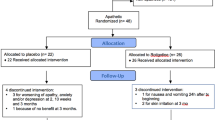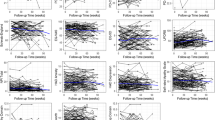Abstract
Apathy is a common behavioural problem in Parkinson’s disease (PD), with important clinical consequences for patients and their families. However, little is known about apathy in early PD. We examined the frequency and clinical characteristics of apathy in 175 nondemented, drug-naïve patients with newly diagnosed PD and 165 control subjects matched for age, sex and education level in Western and Southern Norway. All participants underwent a comprehensive neurological, psychiatric and neuropsychological evaluation. Apathy was diagnosed based on Neuropsychiatric Inventory assessment and recently proposed consensus criteria. Apathy was found in 22.9% of the PD patients, of whom 37.5% had significant depressive symptoms, whereas none of the control subjects were apathetic. Apathy was significantly associated with male gender, higher depression scores and more severe motor symptoms, but was not associated with greater cognitive impairment. When excluding patients with significant depressive symptoms, apathy remained significantly associated with motor severity. Approximately 50% of the caregivers of patients with apathy reported the apathetic behaviour to be at least moderately distressing. The association between apathy and motor severity in our PD cohort suggests a common underlying pathophysiological mechanism. Future studies should explore the longitudinal effect of dopamine replacement therapy on apathetic behaviour in early PD. The relationship between apathy and male gender needs further study to be fully evaluated.
Similar content being viewed by others
References
Alves G, Muller B, Herlofson K, Hogenesch I, Telstad W, Aarsland D, Tysnes OB, Larsen JP (2009) Incidence of Parkinson’s disease in Norway: the Norwegian ParkWest study. J Neurol Neurosurg Psychiatry 80:851–857
Benton AL, Hamsher KD (1989) Multilingual aphasia examination. AJA Associates, Iowa City
Brown RG, Pluck G (2000) Negative symptoms: the ‘pathology’ of motivation and goal-directed behaviour. Trends Neurosci 23:412–417
Braak H, Del Tredici K, Rub U, de Vos RA, Jansen Steur EN, Braak E (2003) Staging of brain pathology related to sporadic Parkinson’s disease. Neurobiol Aging 24:197–211
Cummings JL, Mega M, Gray K, Rosenberg-Thompson S, Carusi DA, Gornbein J (1994) The neuropsychiatric inventory: comprehensive assessment of psychopathology in dementia. Neurology 44:2308–2314
Czernecki V, Pillon B, Houeto JL, Pochon JB, Levy R, Dubois B (2002) Motivation, reward, and Parkinson’s disease: influence of dopatherapy. Neuropsychologia 40:2257–2267
Delis DC, Kramer JH, Kaplan E, Ober BA (2000) CVLT-II. California verbal learning test. Adult Version, 2nd edn, The Psychological Corporation, Harcourt Assessment Inc., San Antonio
Dujardin K, Sockeel P, Devos D, Delliaux M, Krystkowiak P, Destee A, Defebvre L (2007) Characteristics of apathy in Parkinson’s disease. Mov Disord 22:778–784
Emre M, Aarsland D, Brown R, Burn DJ, Duyckaerts C, Mizuno Y, Broe GA, Cummings J, Dickson DW, Gauthier S, Goldman J, Goetz C, Korczyn A, Lees A, Levy R, Litvan I, McKeith I, Olanow W, Poewe W, Quinn N, Sampaio C, Tolosa E, Dubois B (2007) Clinical diagnostic criteria for dementia associated with Parkinson’s disease. Mov Disord 22:1689–1707
Fahn S, Elton RL, Members of the UPDRS Development Committee (1987) Unified Parkinson’s disease rating scale. In: Fahn S, Marsden CD, Calne DB, Goldstein M (eds) Recent developments in Parkinson’s disease. Macmillan Healthcare Information, Florham Park, NJ, pp 153–163
Folstein MF, Folstein SE, McHugh PR (1975) Mini-mental state. A practical method for grading the cognitive state of patients for the clinician. J Psychiatr Res 12:189–198
Gelb DJ, Oliver E, Gilman S (1999) Diagnostic criteria for Parkinson disease. Arch Neurol 56:33–39
Golden CJ, Freshwater SM (1998) The Stroop color and word test. The Stoelting Company, Wood Dale
Hoehn MM, Yahr MD (1967) Parkinsonism: onset, progression and mortality. Neurology 17:427–442
Isella V, Melzi P, Grimaldi M, Iurlaro S, Piolti R, Ferrarese C, Frattola L, Appollonio I (2002) Clinical, neuropsychological, and morphometric correlates of apathy in Parkinson’s disease. Mov Disord 17:366–371
Jorm AF (2004) The informant questionnaire on cognitive decline in the elderly (IQCODE): a review. Int Psychogeriatr 16:275–293
Kaufer DI, Cummings JL, Christine D, Bray T, Castellon S, Masterman D, MacMillan A, Ketchel P, De Kosky ST (1998) Assessing the impact of neuropsychiatric symptoms in Alzheimer’s disease: the neuropsychiatric inventory caregiver distress scale. J Am Geriatr Soc 46:210–215
Kenangil G, Orken DN, Ur E, Forta H, Celik M (2009) The relation of testosterone levels with fatigue and apathy in Parkinson’s disease. Clin Neurol Neurosurg 111:412–414
Kirsch-Darrow L, Fernandez HF, Marsiske M, Okun MS, Bowers D (2006) Dissociating apathy and depression in Parkinson disease. Neurology 67:33–38
Kuhn W, Heye N, Muller T, Kraus P, Klotz P, Friedrich B, Welter FL, Przuntek H (1996) The motor performance test series in Parkinson’s disease is influenced by depression. J Neural Transm 103:349–354
Kulisevsky J, Pagonabarraga J, Pascual-Sedano B, Garcia-Sanchez C, Gironell A (2008) Prevalence and correlates of neuropsychiatric symptoms in Parkinson’s disease without dementia. Mov Disord 23:1889–1896
Leentjens AF, Dujardin K, Marsh L, Martinez-Martin P, Richard IH, Starkstein SE, Weintraub D, Sampaio C, Poewe W, Rascol O, Stebbins GT, Goetz CG (2008) Apathy and anhedonia rating scales in Parkinson’s disease: critique and recommendations. Mov Disord 23:2004–2014
Marin RS (1991) Apathy: a neuropsychiatric syndrome. J Neuropsychiatry Clin Neurosci 3:243–254
Marin RS, Wilkosz PA (2005) Disorders of diminished motivation. J Head Trauma Rehabil 20:377–388
Marsh L, McDonald WM, Cummings J, Ravina B (2006) Provisional diagnostic criteria for depression in Parkinson’s disease: report of an NINDS/NIMH Work Group. Mov Disord 21:148–158
Marsh L (2006) Behavioral disturbances. In: Menza M, Marsh L (eds) Psychiatric issues in Parkinson’s disease, a practical guide. Taylor & Francis, London, pp 193–218
Montgomery SA, Asberg M (1979) A new depression scale designed to be sensitive to change. Br J Psychiatry 134:382–389
Pedersen KF, Alves G, Aarsland D, Larsen JP (2009) Occurrence and risk factors for apathy in Parkinson’s disease: a 4-year prospective longitudinal study. J Neurol Neurosurg Psychiatry. doi:10.1136/jnnp.2008.170043
Pedersen KF, Larsen JP, Alves G, Aarsland D (2009) Prevalence and clinical correlates of apathy in Parkinson’s disease: a community-based study. Parkinsonism Relat Disord 15:295–299
Pluck GC, Brown RG (2002) Apathy in Parkinson’s disease. J Neurol Neurosurg Psychiatry 73:636–642
Ready RE, Friedman J, Grace J, Fernandez H (2004) Testosterone deficiency and apathy in Parkinson’s disease: a pilot study. J Neurol Neurosurg Psychiatry 75:1323–1326
Reijnders JS, Ehrt U, Weber WE, Aarsland D, Leentjens AF (2008) A systematic review of prevalence studies of depression in Parkinson’s disease. Mov Disord 23:183–189
Robert P, Onyike CU, Leentjens AF, Dujardin K, Aalten P, Starkstein S, Verhey FR, Yessavage J, Clement JP, Drapier D, Bayle F, Benoit M, Boyer P, Lorca PM, Thibaut F, Gauthier S, Grossberg G, Vellas B, Byrne J (2009) Proposed diagnostic criteria for apathy in Alzheimer’s disease and other neuropsychiatric disorders. Eur Psychiatry 24:98–104
Schrag A, Barone P, Brown RG, Leentjens AF, McDonald WM, Starkstein S, Weintraub D, Poewe W, Rascol O, Sampaio C, Stebbins GT, Goetz CG (2007) Depression rating scales in Parkinson’s disease: critique and recommendations. Mov Disord 22:1077–1092
Schrag A, Jahanshahi M, Quinn NP (2001) What contributes to depression in Parkinson’s disease? Psychol Med 31:65–73
Schwab RS, England AC (1969) Projection technique for evaluating surgery in Parkinson’s disease. In: Third Symposium on Parkinson’s disease, Royal College of Surgeons in Edinburgh. E&S Livingstone Ltd., pp 152–157 (Table 1, p 153)
Starkstein SE, Mayberg HS, Preziosi TJ, Andrezejewski P, Leiguarda R, Robinson RG (1992) Reliability, validity, and clinical correlates of apathy in Parkinson’s disease. J Neuropsychiatry Clin Neurosci 4:134–139
Starkstein SE, Merello M, Jorge R, Brockman S, Bruce D, Petracca G, Robinson RG (2008) A validation study of depressive syndromes in Parkinson’s disease. Mov Disord 23:538–546
Warrington EK, James M (1991) The visual object and space perception battery. Thames Valley Test Company, Bury St Edmunds
Aarsland D, Bronnick K, Ehrt U, De Deyn PP, Tekin S, Emre M, Cummings JL (2007) Neuropsychiatric symptoms in patients with Parkinson’s disease and dementia: frequency, profile and associated care giver stress. J Neurol Neurosurg Psychiatry 78:36–42
Aarsland D, Bronnick K, Larsen JP, Tysnes OB, Alves G (2009) Cognitive impairment in incident, untreated Parkinson disease: the Norwegian ParkWest study. Neurology 72:1121–1126
Aarsland D, Bronnick K, Alves G, Tysnes OB, Pedersen KF, Ehrt U, Larsen JP (2009) The spectrum of neuropsychiatric symptoms in patients with early untreated Parkinson’s disease. J Neurol Neurosurg Psychiatry 80:928–930
Aarsland D, Larsen JP, Lim NG, Janvin C, Karlsen K, Tandberg E, Cummings JL (1999) Range of neuropsychiatric disturbances in patients with Parkinson’s disease. J Neurol Neurosurg Psychiatry 67:492–496
Acknowledgments
The authors are grateful to all patients and control subjects for their willingness to participate in this study. We also thank all personnel who contributed to planning and conducting this study.
The Norwegian ParkWest study was funded by the Western Norway Regional Health Authority (grant# 911218) and the Research Council of Norway (grant# 177966).
Author information
Authors and Affiliations
Corresponding author
Additional information
For the Norwegian ParkWest Study Group.
Appendix
Appendix
The Norwegian ParkWest Study Group consists of: Study neurologists—Guido Alves, Elin Bjelland Forsaa, Michaela Dreetz Gjerstad, Karen Herlofsen, Ineke HogenEsch, Jan Petter Larsen, Bernd Müeller, Kenn Freddy Pedersen, Geir Olve Skeie, Wenche Telstad, Ole-Bjørn Tysnes, and Corinna Vossius. Study nurses—Britt Bruland, Siri Bruun, Marit Ellefseth, Liv Kari Haaland, Janet Kastet, Marianne Kjærandsen, Anita Laugland, Ingrid Leiknes, Kirsten Lode, Kristina Rasmussen, Marit Arnevik Renså, and Gro Tønnesen.
Rights and permissions
About this article
Cite this article
Pedersen, K.F., Alves, G., Brønnick, K. et al. Apathy in drug-naïve patients with incident Parkinson’s disease: the Norwegian ParkWest study. J Neurol 257, 217–223 (2010). https://doi.org/10.1007/s00415-009-5297-x
Received:
Revised:
Accepted:
Published:
Issue Date:
DOI: https://doi.org/10.1007/s00415-009-5297-x




